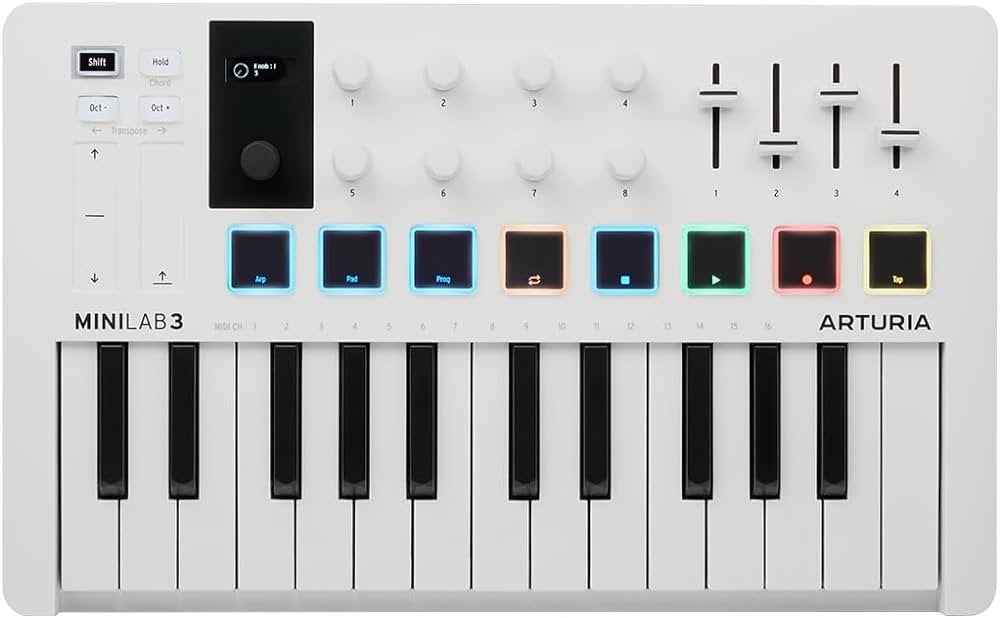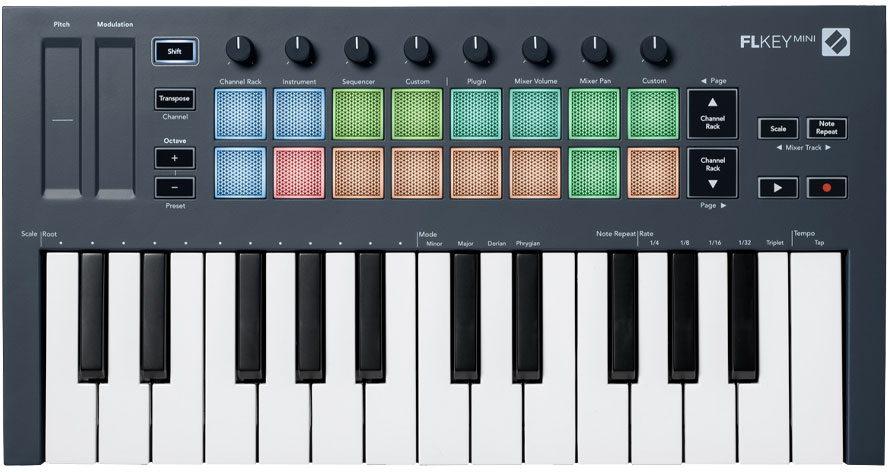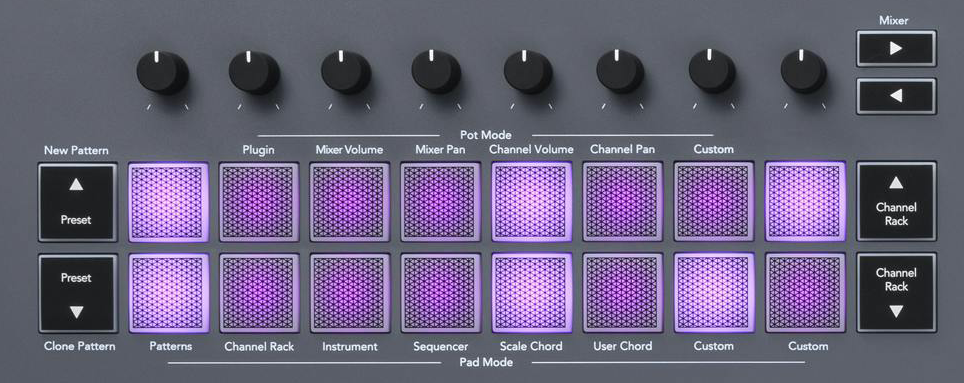A guide to beginner MIDI Controller Keyboards
As much as the qwerty keyboard has given us incredible access and control over the plethora of programmes that populate your PC or Mac, it can never be considered a musical instrument. Lacking velocity and touch sensitivity and having incredibly small keys, I mean they are miniscule! The need for a more musically familiar input device was apparent. Thankfully we have had MIDI Controller Keyboards for the past 4 decades starting with the groundbreaking Sequential Circuits Six Trak Keyboard which gave us the very first real time MIDI control.
Why choose an entry level MIDI Controller Keyboard?
So regardless of your experience as a digital musician there are plenty of use cases for using one of the smaller, cheaper controllers. For beginners the simplicity of the layout, set-up and integration make an entry level controller very attractive. For more experienced musicians the portability, compactness and again simplicity of integration make an entry level controller an ideal choice for the travelling musician looking to make music either on the move or while touring and staying at hotels.
There are some differences between the available MIDI Controller Keyboards classified as beginner to consider. Most sub £100 MIDI Controller Keyboards will share some similarities, notably, they almost to a keyboard, have 25 keys. Although this would limit expressiveness its compactness means it can fit in small home studios easily and travels well. They are all USB powered so no need for additional power adapters, no mains power means no need for travel adapters, consolidating their portability. So let’s dive in!
Nektar SE25 25 mini keys USB MIDI Controller

The Nektar is as simple as a MIDI controller Keyboard gets and its compactness is what makes it so popular. Don’t be fooled by its basic layout, under the hood are a range of sophisticated features that will make creating music on the go a breeze. Aside from the velocity enabled key bed which has 3 different levels of velocity there is the ability to move between octaves of the keyboard at the press of a button. There are basic transport controls making life much easier to drop in over dubs without having to panic reach for the mouse. If you press S + 2 together you enter setup mode and can now access the three alternate modes underscored by the red lines. In this mode you can change pitch bend like you would do with a jog wheel, change tempo, transpose key, adjust pan and access different tracks and patches.
For further depth in this mode, you can layer octaves so you get two notes for the price of one key. You can add sustain to your notes and chords and trigger modulation.
When you purchase the Nektar SE25 you will also receive a copy of BITWIG 8-TRACK and BITWIG ESSENTIALS to get your musical journey started.
The Nektar SE25 is about as wide as a medium laptop and as such fits nicely within the footprint of most laptops making it usable in most situations from the table to your lap. It fits easily into a holdall and is incredibly light yet durable for the price.
Arturia MiniLab Mk 3 25 Note Velocity-Sensitive Slim Keyboard

In the world of musical hardware finishing your product in white would be regarded as madness, Arturia, however have made it their own, a unique approach in a world of matte-black plastic sets Arturia apart, almost aloof. With their elegant clean lines and monochromatic layout they have tapped into something in the human psyche, clean, clinical and surgical hardware that fits beautifully in minimal set ups where the minimisation of clutter is a must.
The Arturia MiniLab MK3 packs a middleweight punch in a featherweight body. Split between the 25 note velocity sensitive key bed below and the twist, push, pull, tap and slide of the top half, the Arturia has a plethora of instant access control, there are still some properties that must be accessed via shift mode but Arturia have made a conscious effort to give the digital musician as much control as possible with as little fuss as neccessary.
Normally this is where I would dive into pads and pots functionality but I think we should get through the small but highly featured Shift mode. The first button and only one cell shaded in the top left of the unit is the “shift mode” button, when this button is pressed and held it will allow you to activate a number of functions.
Shift Mode
- • Hold Button: Engages or disengages Chord Mode. Long-pressing while holding Shift enters Create Chord mode.
- • Octave Shift Buttons: Transpose the keyboard up or down in semitones.
- • Dentented Main Encoder knob: Varies depending on connected software.
- • Pad 1: Toggles Arpeggiator [p.9] on and off. Long-pressing the pad while holding Shift enters Arp Edit mode.
- • Pad 2: Switches pads between bank A and bank B.
- • Pad 3: Switches MiniLab 3 modes between Arturia instrument control and DAW control modes. From here, you can also switch between User Programs you have created.
- • Pads 4–7: Controls transport of connected DAW (Loop mode on/off, Stop, Play, and Record).
- • Pad 8: Allows you to enter Tap Tempo information. Keyboard F in first octave to G# in second octave select MIDI transmit channels 1–16.
There are two direct access octave buttons that allow you to move the keyboard between lower and higher octaves of the keyboard. There is an OLED display that shows the present state of a particular function. The MiniLab MK3 has a central control button that allows you to navigate presets and plugins within your chosen DAW and is also clickable to make choosing said preset as easy as possible.
There are 8 pots that again allow you to control various functions within assigned plugins, instruments, channels, and panels within your DAW of choice. These in some case will default to certain parameters within the DAW but can also be MIDI assigned to custom parameters.
There are 8 touch sensitive, velocity pads ideal for finger drumming and triggering MIDI notes and samples. Finally, there are four faders allowing the user to control elements within plugins, instruments, channels, and panels.
The Arturia MiniLab MK 3 is abundant with features and controls and has one of the most pleasing looks in the controller keyboard world. Arturia are a forward-thinking company who look to support there customers with an array of software and when you purchase the MiniLab MK 3 you get access to Ableton Live Lite, Loopcloud, Native Instrument - The gentleman, and many other pieces of incredible software.
Novation - FLkey Mini, 25 Key MIDI Keyboard Controller for FL Studio

A sight digression away from the broader MIDI controller conversation, quite a few manufacturers have created DAW specific MIDI controllers allowing a deeper level of control and intuitive performance than with an off-brand controller. Novation does a range of non-specific controllers that integrate with a ranger of DAWs, plugins and digital instruments called Launchkey, but I though it would be interesting to cover the use case of a DAW specific controller keyboard.
Firstly why? The obvious answer is ease of use. If like me you use one specific DAW almost exclusively, having a specific controller that not only integrates but can reduce your non-performance/programming time down considerably by having assigned pots, pads and faders to oft used functions within the DAW is as they say a no brainer. Also having said pots, pads and faders that automatically integrate to plugins and instruments improves and extends the controller as a genuine instrument that can inspire performance and writing.
The Novation FL Key Mini integrates with FL Studio seamlessly. FL studio for someone like me, used to a conventional channel stack is a bit daunting, particular the sequencer which can take a bit of time getting used to particularly if you need to record a live performance. The Novation FL Key Mini makes navigating the sequencer, the channel rack and the mixing panels a breeze.
The Novation FL Key Mini still has all the accoutrements of a non-specific controller such as touch sensitive velocity pads, assignable MIDI pads, pots and faders but also has Scale and chord modes making performance even easier. If like me you are a terrible piano player and want to perform more complex melodies in a certain key you can set the FL Key to scale or chord mode and stay within a certain a) scale or b) key meaning you never play a wrong or out of tune note.
Where the Novation FL Key Mini sets itself apart, the sequencer mode is a level above most. The sequencer is a massive and integral part of FL Studio with it repeatable bars being a foundation for the huge community of electronic dance music makers that largely comprise the FL community. The sequencer on the FL Key Mini is superbly intuitive, it replicates the colour of the chosen channel track, it highlights any activated step in the sequence as a brighter hue of the channel colour and dims any non-active steps.

The Novation FL Key Mini is a slight departure from general MIDI controller keyboards but highlights just how sophisticated these hardware controllers can be. If you are a parent looking for a reasonably inexpensive present and know what DAW you child prefers this can be a clever and affordable choice of present.
Thankfully the world of entry level controller keyboards is easy to navigate, most of the keyboards share the same functionality and largely hover around the same price point. Even the controller keyboards that are pitched as specific to a particular DAW often work seamlessly across all digital audio workstations.
Please browse our range of controller keyboards here >And if you have any further questions, please reach out to us at [email protected]